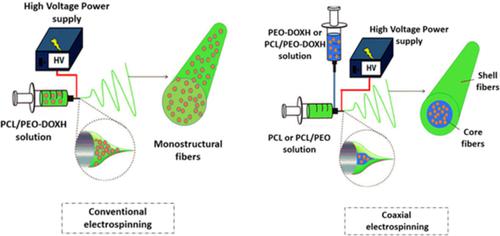当前位置:
X-MOL 学术
›
J. Appl. Polym. Sci.
›
论文详情
Our official English website, www.x-mol.net, welcomes your
feedback! (Note: you will need to create a separate account there.)
Controlled release of doxycycline within core/shell poly(ε‐caprolactone)/poly(ethylene oxide) fibers via coaxial electrospinning
Journal of Applied Polymer Science ( IF 2.7 ) Pub Date : 2020-03-25 , DOI: 10.1002/app.49273 Ş. Melda Eskitoros‐Togay 1 , Y. Emre Bulbul 1 , Nursel Dilsiz 2
Journal of Applied Polymer Science ( IF 2.7 ) Pub Date : 2020-03-25 , DOI: 10.1002/app.49273 Ş. Melda Eskitoros‐Togay 1 , Y. Emre Bulbul 1 , Nursel Dilsiz 2
Affiliation

|
The development of fibers with desired drug release properties has gained a high research interest for water‐soluble drugs with controlled drug delivery systems obtained by coaxial electrospinning technique. The objective of this study is to achieve the controlled‐release of doxycycline hyclate (DOXH) from the fabricated electrospun fibers. In this case, three different electrospun core/shell fibers have been successfully fabricated using this technique and the model drug, DOXH, has been entrapped in the core layers. The results of the structural properties and in vitro release studies have been compared with electrospun monostructural fibers fabricated by conventional electrospinning technique. Scanning electron microscopy and transmission electron microscopy images have proved that the fabricated electrospun fibers have core/shell structures. Fourier transform infrared spectroscopy has shown convenient interaction and compatibility between polymers and the model drug. X‐ray diffraction analysis has revealed that all the encapsulated DOXH are transferred into amorphous physical state and lost its crystalline state in the fibers. Moreover, drug release studies have demonstrated that the electrospun core/shell fibers show a better‐controlled release than the monostructural fibers. It can be concluded that the fibers obtained by blending hydrophilic and hydrophobic polymers such as poly(ε‐caprolactone) and poly(ethylene oxide) in both shell and core sides are promising candidate for controlled drug release.
中文翻译:

通过同轴静电纺丝控制多西环素在核/壳聚(ε-己内酯)/聚(环氧乙烷)纤维内的释放
具有期望的药物释放特性的纤维的开发已经获得了对具有通过同轴电纺丝技术获得的可控药物递送系统的水溶性药物的高度研究兴趣。这项研究的目的是实现从制造的电纺纤维中控制释放多西环酸氢根(DOXH)。在这种情况下,已使用该技术成功制造了三种不同的电纺芯/壳纤维,并且模型药物DOXH已被包埋在芯层中。结构特性和体外释放研究的结果已经与通过常规电纺丝技术制造的电纺单结构纤维进行了比较。扫描电子显微镜和透射电子显微镜图像已经证明,所制造的电纺纤维具有核/壳结构。傅里叶变换红外光谱显示出聚合物与模型药物之间的便利相互作用和相容性。X射线衍射分析表明,所有包封的DOXH均转变为非晶态,并在纤维中失去了结晶态。此外,药物释放研究表明,电纺芯/壳纤维显示出比单结构纤维更好的控制释放。可以得出结论,通过在壳和核的两面混合亲水性和疏水性聚合物(例如聚(ε-己内酯)和聚环氧乙烷)获得的纤维有望成为控制药物释放的候选材料。X射线衍射分析表明,所有包封的DOXH均转变为非晶态,并在纤维中失去了结晶态。此外,药物释放研究表明,电纺芯/壳纤维显示出比单结构纤维更好的控制释放。可以得出结论,通过在壳和核的两面混合亲水性和疏水性聚合物(例如聚(ε-己内酯)和聚环氧乙烷)获得的纤维有望成为控制药物释放的候选材料。X射线衍射分析表明,所有包封的DOXH均转变为非晶态,并在纤维中失去了结晶态。此外,药物释放研究表明,电纺芯/壳纤维显示出比单结构纤维更好的控制释放。可以得出结论,通过在壳和核的两面混合亲水性和疏水性聚合物(例如聚(ε-己内酯)和聚环氧乙烷)获得的纤维有望成为控制药物释放的候选材料。
更新日期:2020-03-25
中文翻译:

通过同轴静电纺丝控制多西环素在核/壳聚(ε-己内酯)/聚(环氧乙烷)纤维内的释放
具有期望的药物释放特性的纤维的开发已经获得了对具有通过同轴电纺丝技术获得的可控药物递送系统的水溶性药物的高度研究兴趣。这项研究的目的是实现从制造的电纺纤维中控制释放多西环酸氢根(DOXH)。在这种情况下,已使用该技术成功制造了三种不同的电纺芯/壳纤维,并且模型药物DOXH已被包埋在芯层中。结构特性和体外释放研究的结果已经与通过常规电纺丝技术制造的电纺单结构纤维进行了比较。扫描电子显微镜和透射电子显微镜图像已经证明,所制造的电纺纤维具有核/壳结构。傅里叶变换红外光谱显示出聚合物与模型药物之间的便利相互作用和相容性。X射线衍射分析表明,所有包封的DOXH均转变为非晶态,并在纤维中失去了结晶态。此外,药物释放研究表明,电纺芯/壳纤维显示出比单结构纤维更好的控制释放。可以得出结论,通过在壳和核的两面混合亲水性和疏水性聚合物(例如聚(ε-己内酯)和聚环氧乙烷)获得的纤维有望成为控制药物释放的候选材料。X射线衍射分析表明,所有包封的DOXH均转变为非晶态,并在纤维中失去了结晶态。此外,药物释放研究表明,电纺芯/壳纤维显示出比单结构纤维更好的控制释放。可以得出结论,通过在壳和核的两面混合亲水性和疏水性聚合物(例如聚(ε-己内酯)和聚环氧乙烷)获得的纤维有望成为控制药物释放的候选材料。X射线衍射分析表明,所有包封的DOXH均转变为非晶态,并在纤维中失去了结晶态。此外,药物释放研究表明,电纺芯/壳纤维显示出比单结构纤维更好的控制释放。可以得出结论,通过在壳和核的两面混合亲水性和疏水性聚合物(例如聚(ε-己内酯)和聚环氧乙烷)获得的纤维有望成为控制药物释放的候选材料。











































 京公网安备 11010802027423号
京公网安备 11010802027423号